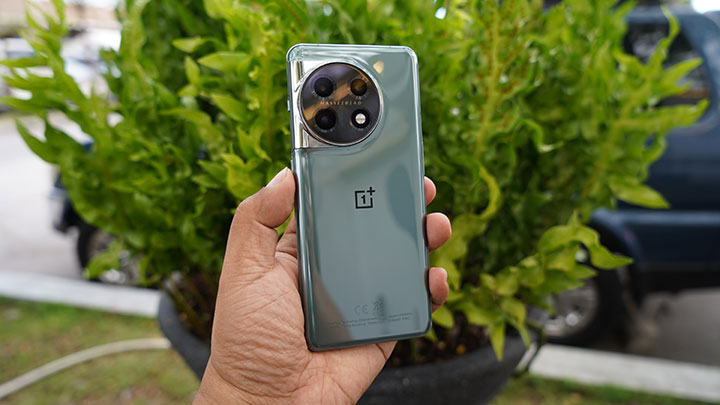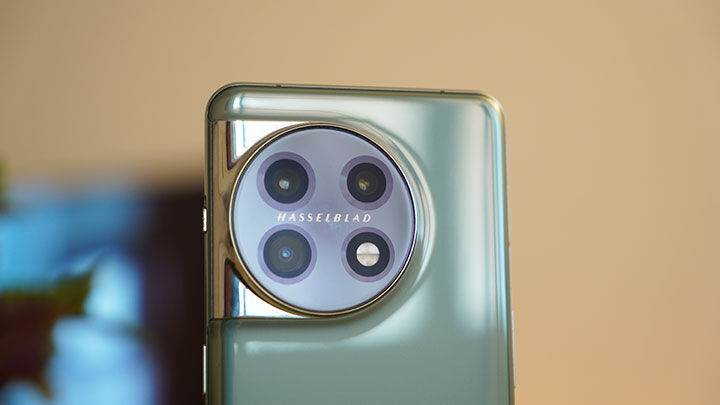OPPO has officially announced the global version of the OnePlus 11 5G and, after everything has been revealed, it’s time for us to share with you our verdict of this new flagship handset.
Before anything else, we realized that a lot has happened with OnePlus in the past couple of years.

That’s just the major ones, and there are a few more, but we think OnePlus is in a better position now than ever before. With the OnePlus 11 being the latest flagship handset, can we say it is still a flagship killer?
Table of Contents
Let’s get into the meat of things first — the OnePlus 11 takes off from last year’s OnePlus 10 Pro. We can assume that there will be no Pro version this year as the 11 is the top handset in the lineup, along with a more conservative OnePlus 11R.

The OnePlus 11 has an almost identical design to the OnePlus 10 Pro. Except for that camera module at the back that used to be squarish and now half circular. I don’t know about you but I kind of like this one better. Besides, how else will people know you have the latest OnePlus 11 and not the old 10 Pro, right?
Kidding aside, we are digging the looks of the OnePlus 11. Curved glass front, tapered edges at the back, rounded corners and whole lot of glass. And did we mention it’s Gorilla Glass Victus at the front and Gorilla Glass 5 at the back?

At the bottom end, you have the Type C charging port, speaker grill, primary mic and the SIM tray slot. On the left side is the volume rocker while you get a second noise-canceling mic and 2nd stereo speaker grill up top.

At the right side, you have the power button and, well, well, well — the Alert Slider. It has been a OnePlus signature feature for such a long time and was briefly removed from the OnePlus 10T and 10R, something that a lot of OG fans loved about it. It is placed well above the power button with a rough surface so you can easily figure it out.

Our review units is in the Emerald Green color and, as mentioned before, is polished in this glossy finish due to the glass component.
However, there is another color variant that is the Volcanic Black which has more of a matte finish at the back.
As for the display, it is still the same 6.7-inch 2K 120Hz AMOLED screen, just like the 10 Pro, but this time they upgraded to an LTPO3 display tech. That means it can variably adjust the screen refresh rate from 1Hz to 120Hz and saving you more battery life. Colors are vibrant, images are clear and crisp.

Peak brightness goes up to 1,300 nits but when you use it outdoors, the glare can be too overwhelming and you will have a hard time reading from the screen.

The curved screen may be more prone to accidental touches but so far we rarely experience this even during the many hours of mobile gaming we have done on the phone. Some people hate it, but we like it as it feels more immersive and the tiny bezels almost disappear entirely.
The under-display fingerprint sensor is placed just at the right location so it’s comfortable to reach at and very responsive to the touch. You can also use the facial-recognition as a security option and found it to be pretty accurate for the most part. So far, we’ve been able to use it to quickly sign in to our apps like GCash or the one from SecurityBank.

The whole metal frame and glass exterior at the front and back feels really, really premium. It is slippery and all to the hands; can be a smudge magnet at the back but that glossy finish does give it an elegant and pristine look — you just want to polish it every so often. Otherwise, just slap a transparent jelly case and you are all set.
Performance is at the heart of the OnePlus ethos. So you get flagship-level hardware here — a Snapdragon 8 Gen2, a massive 16GB of memory (plus 12GB of RAM expansion for a total of 28GB) and 512GB of UFS 4.0 internal storage. That is more than enough space for you to forget it does not have a microSD expansion slot.

And true enough, the OnePlus 11 is blazing fast, super snappy, and responsive that everything you run on it just works buttery smooth. Games like Mobile Legends and Asphalt 9 play like a breeze, and more graphics-extensive games like Genshin Impact runs as smoothly as one would expect.

If you are looking for numbers from synthetic benchmarks, check out the results below.
Antutu Benchmark v9.4.4: 1,025,677
Antutu Storage: 3,316.9MB/s (Read), 2,649.7MB/s (Write), 351.5MB/s & 519.1MB/2 (Random Read/Write)
GeekBench v5.4.6: 1,161 (Single Core, 4,661 (Multi-core), 8,779 (Vulkan Score),
PCMark 3.0: 10,869
3DMark: 3,580 (Wild Life Extreme),
Storage read and write speeds are thru the roof, with more than twice the numbers we got from the OnePlus 10 Pro, all thanks to the UFS 4.0 technology.
Now, on to the camera. At the back, we have a camera setup that is basically a threesome of Sony IMX sensors.

This is headlined by a 50-megapixel Sony IMX890 which has an aperture of f/1.8 and comes with optical image stabilization, a 48 megapixel ultra-wide lens using a Sony IMX581 with f/2.2 aperture and a 32-megapixel telephoto lens that uses a Sony IMX709 sensor, f/2.0 aperture and RGBW light-harvesting sensor we first saw in the OPPO Reno7 back in 2021.

The OnePlus 11 is the 3rd generation handset to come with Hasselblad’s Natural Color Calibration. this means software improvements on color tuning, sensor calibration, and other imaging innovations. There’s 10-bit color support here too.
If you’ve been using a OnePlus phone since the OnePlus 9, you can clearly notice the distinction or the way the photos are influenced by Hasselblad. Images are more natural, a bit more vibrant than usual but sometimes a little highlighted in some scenarios.
Check out some of the samples we took here.
We noticed that the main and ultra-wide camera have more or less very similar image quality output, which we seldom see in many multi-camera setup. Exposure and detail oftentimes degrade significantly when switching between the main and the ultra-wide but with the OnePlus 11, the two are almost in sync with each other. Perhaps, that’s already the Hasselblad software at work.
For video, you can shoot up to 4k at 60fps or 8k at 24fps. Image stabilization on video is also good and stable.
For the most part, we are thoroughly impressed with the optics of the OnePlus 11.
As we mentioned earlier, OnePlus and OPPO merged their respective OS to develop a more robust and stable environment for their handsets. In China, they use ColorOS but in international markets, they use OxygenOS.

On the surface, OxygenOS still looks a bit different with ColorOS. Perhaps, the marriage between the two is more on the code base of the operating system so it will take some time for us to really feel the benefits here.
Also, props to OnePlus for giving credit to the community that helped build their OS — they even had a special page dedicated to all the contributors.

Otherwise, OxygenOS 13 is still the same familiar feel with lots of customization you can tinker about. You can choose between Standard mode UI or Drawer mode, select between Notification Drawer or Shelf when you swipe down from the Home Screen, Raise to Wake, Double Tap to Wake or Sleep, or you can enable Wake Google Assistant with the Home button.

Just like in ColorOS, OxygenOS also has O-Haptics, which adds feedback for touches, swipes, and more. Other special features include Split Screen, Flexible windows, Quick launch, and Smart sidebar.
There are enough customization options here for you to mess around with and make the whole UI experience as close or comfortable to your liking.
For connectivity, everything is covered here — WiFi 6, Bluetooth 5.3, GPS with aGPS support, NFC and 5G from the dual nano SIM card. Those stereo speakers can blast music to your heart’s desire. In short, it’s pretty loud.

Of course, a powerful hardware must require a massive battery in order for you to enjoy it without worrying about charging it back to life. Well, that’s why they packed this handset with a 5,000mAh battery but just to be safe, they also included a 100W SuperVOOC fast charger that can get to 50% in about 10 minutes and fully charged in just 25 minutes.
Using PCMark 3.0 Battery test, the device managed to score 15 hours and 43 minutes on a single full charge at 50% brightness, zero volume and in airplane mode. That’s already impressive considering the all the hardware the handset is powering.
While you’d think the OnePlus 11 is a full-fledged to the OnePlus 10 Pro, there’s a caveat though. A number of features are missing if you’re coming from the OnePlus 10 Pro.

We don’t really know why they had to downgrade these aspects of the hardware. Even the basic ones, like the USB Type C 2.0, do not make any sense to us. If it’s any consolation, there’s IP68 dust and water resistance here as well.
In any case, this does not make the OnePlus 11 any less desirable, well, at least for us. In fact, we think it’s the opposite.

It is a pretty nice flagship-level device — great design, impressive performance, good battery life, an impressive set of cameras, and an over-all well-rounded smartphone.
As for the release date and price in the Philippines, OPPO has not provided more details but they have promised to provide us with information once it becomes available.
OnePlus 11 5G specs:
6.7-inch QHD+ (3216 x 1440) Samsung E4 AMOLED display
120Hz refresh rate, LTPO 3.0 panel, 525 ppi
Dolby Vision support, 1300 nits peak brightness
Corning Gorilla Glass ‘7th Gen’
Qualcomm Snapdragon 8 Gen 2 SoC (4nm)
12GB, 16GB LPDDR5X RAM
256GB, 512GB UFS 4.0 storage
Triple rear cameras, tuned by Hasselblad:
• 50MP f/1.8 Sony IMX890 main, OIS
• 48MP f/2.2 Sony IMX581 ultrawide, FoV 115°
• 32MP f/2.0 Sony IMX709 RGBW telephoto (2x optical, 20x digital zoom)
16MP f/2.4 front
Dual nano-SIM
5G, 4G LTE
WiFi-7
Bluetooth 5.3
GPS with aGPS support
USB Type-C 2.0
NFC
Dual stereo speakers, Dolby Atmos support
Under-display fingerprint sensor
OxygenOS 13 (Android 13)
5000mAh, 100W SuperVOOC charger
163.1 x 74.1 x 8.53 mm (dimensions)
205 grams (weight)
Emerald Green, Volcanic Black

YugaTech.com is the largest and longest-running technology site in the Philippines. Originally established in October 2002, the site was transformed into a full-fledged technology platform in 2005.
How to transfer, withdraw money from PayPal to GCash
Prices of Starlink satellite in the Philippines
Install Google GBox to Huawei smartphones
Pag-IBIG MP2 online application
How to check PhilHealth contributions online
How to find your SIM card serial number
Globe, PLDT, Converge, Sky: Unli fiber internet plans compared
10 biggest games in the Google Play Store
LTO periodic medical exam for 10-year licenses
Netflix codes to unlock hidden TV shows, movies
Apple, Asus, Cherry Mobile, Huawei, LG, Nokia, Oppo, Samsung, Sony, Vivo, Xiaomi, Lenovo, Infinix Mobile, Pocophone, Honor, iPhone, OnePlus, Tecno, Realme, HTC, Gionee, Kata, IQ00, Redmi, Razer, CloudFone, Motorola, Panasonic, TCL, Wiko
Best Android smartphones between PHP 20,000 - 25,000
Smartphones under PHP 10,000 in the Philippines
Smartphones under PHP 12K Philippines
Best smartphones for kids under PHP 7,000
Smartphones under PHP 15,000 in the Philippines
Best Android smartphones between PHP 15,000 - 20,000
Smartphones under PHP 20,000 in the Philippines
Most affordable 5G phones in the Philippines under PHP 20K
5G smartphones in the Philippines under PHP 16K
Smartphone pricelist Philippines 2024
Smartphone pricelist Philippines 2023
Smartphone pricelist Philippines 2022
Smartphone pricelist Philippines 2021
Smartphone pricelist Philippines 2020